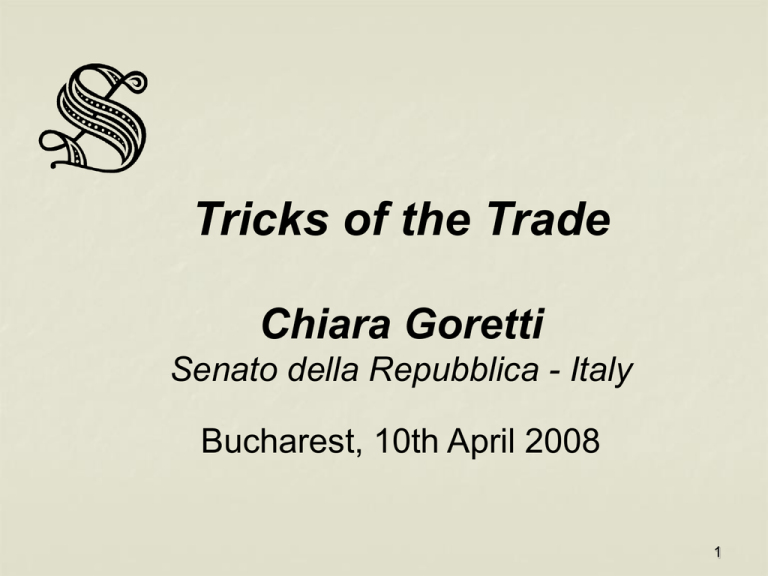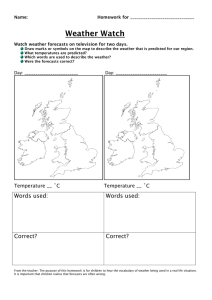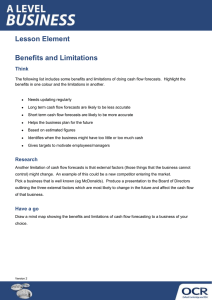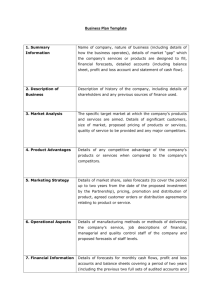Tricks of the Trade Chiara Goretti Senato della Repubblica - Italy
advertisement

Tricks of the Trade Chiara Goretti Senato della Repubblica - Italy Bucharest, 10th April 2008 1 Outline Fiscal rules: incentive to creative accounting Forecasts: optimism bias Stock-flow adjustment: Infrastructures: the ISPA case Railway transfers Securitisation and lease back Tax collectors Conclusions 2 Fiscal rules: incentive to creative accounting From restricted to non restricted activities The EMU case: optimistic growth forecasts deficit vs debt bias: the stock-flow adjustment fiscal surveillance: an evolving statistic and accounting model Coherence of definitions and quality of data 3 Forecasts: optimism bias There is evidence of a significant degree of optimism in a number of euro area countries: boosting projected revenues and containing some types of spending; In 2000, the prevailing buoyant economic conditions were taken to be average or normal: medium-term growth prospects were erroneously assessed to be very bright; Afterwards, budgetary developments dramatically worsened. 4 Forecasts Contemporaneous growth conditions and macroeconomic forecasts (simple average of EU-15 countries) 4% Revisions of the output gap estimate for 2000 in successive Commission Services' forecasts 10,0% 2,5 Real GDP growth in the year of preparation of the SCP (lhs) 2 9,5% SCP projections: average planned cumulated increase in real GDP over three years (rhs) 9,0% 2% 8,5% cumulative change y-o-y change 3% 1,5 1 0,5 0 1% 2000 8,0% 2001 2002 2003 2004 2005 2006 -0,5 0% 7,5% 1998 1999 Source: Commission services 2000 2001 2002 2003 2004 2005 -1 2006 Germany Italy France UK 5 Forecasts: Italy Italy - Economic forecasts in Stability Programmes Budgetary effect of growth surprise 2002 2003 2004 Potential growth ΔCAB 2.4 Planned 2.2 1.8 0 . 6 0 . 5 Δ C 0 . 2 0 . 6 P o 1 . 6 1 . 7 Δ C A B 0 . 9 0 . 1 Δ C A P 0 . 1 1 . 3 3,5 3 2,5 A P B 2 0 . 2 1 . 9 0 . 3 1 . 4 0 Outcome 1,5 t e n t i a l g r o w t h B - 0 . 3 0 1 O n e o f f m e a s u r e s 1 . 9 0,5 0 Δ C A B Δ C A P e x B c e l x o c l n e o n o e f f o s f 0 f s - . 0 2 . 5 1998 1999 2000 2001 2002 2003 2004 2005 2006 2007 2008 2009 2010 2011 actual data SP1999 SP2000 SP2001 SP2002 SP2003 SP2004 SP2005 SP2006 SP2007 - 0 . 5 0 . 8 - 0 . 9 0 . 5 0 . 1 Effect of growth surprise o n Δ C A B - 0 . 4 - 0 . 2 ΔCAB - fiscal effort as measured by the annual change in cyclically adjusted balance ΔCAPB - fiscal effort as measured by the annual change in cyclically adjusted primary balance Source: EU Commission 6 Forecasts: lessons In a rules-based fiscal framework that sets limits on the budget balance, negative growth surprises will necessarily require a downward adjustment of expenditure plans; Budgetary plans should be built on economic growth projections which possibly err on the side of caution. 7 The stock-flow adjustment (SFA) Deficit vs debt bias: from restricted to unrestricted activities; Reconciliation between: cash and accrual data; stock and flow indicators; Consistency across the data; Debtt – Debtt-1 = Deficitt + SFA 8 ISPA ISPA (created in 2002): joint-stock company (outside GG); Entire financing of high speed railway, raising money and providing proceed to RFI and TAV (both outside GG) to finance infrastructures; In 2005, Eurostat decided all debt issued by ISPA is to be recorded as gvt debt, with a counterpart as financial transaction in the form of a loan from gvt to RFI-TAV; In 2006, gvt consolidated the ISPA debt, for transparency reasons, with an increase in deficit of about 13 billions. 9 Railway transfers Capital injections into the state-owned companies are treated as financial transactions; From 2004 on, capital transfers are treated as economic item after Eurostat decision 98/03 (if the company presents losses); Revisions to deficit figures in March 2005 due to railway capital injections: 3.6 billion/euro for 2001; 4.1 b/e for 2002; 4.0 b/e for 2003; 10 Real estate: securitisation and lease-back 2001 and 2002: securitisation operations concerning a portfolio of buildings owned by the Social Security Fund (SCIP); In 2002, Eurostat decided that – if the initial payment is < 85% of the market price - securitisation are to be recorded as financial items until the full payment is made; Revisions of deficit figures for 2001 and 2002; Lease-back (FIP) of central and local building used as offices, then rented back to gvt; Revenues for 3 bn euro in 2004 e 0.6 bn in 2005. 11 Tax collectors From 1997, tax collectors have to advance the payment of indirect taxes due in the following year; budgetary impact only in the first year; In 2003, gvt introduced another type of prepayments; In 2005, Eurostat decided that pre-payments have to be recorded as financial transactions, without improving, in 2003 and 2004, the deficit; December 29th, 2007, pre-payments by tax collectors abolished, in order to worsen the balance. 12 Securitisation Treasury Single Account -cash flows 2004 120.000 100.000 80.000 60.000 40.000 20.000 0 Jan. Feb. Mar. Apr. May June Revenue July Aug. Sept. Oct. Nov. Dec. Expenditure Treasury Single Account - cash flows December 2004 18.000 16.000 14.000 12.000 10.000 8.000 6.000 4.000 2.000 0 1 2 3 6 7 9 10 13 14 15 16 17 20 21 22 23 24 27 28 29 30 31 Revenue Expenditure 13 Data: statistical deficit revisions first release June 02 Sep 02 Mar 03 Sep 03 Mar 04 Sep 04 Mar 05 May 05 2001 1.4 1.6 2.2 2.6 2.6 2.6 2.6 3 3.2 2002 2003 2004 2.3 2.3 2.3 2.3 2.6 2.7 2.4 2.4 2.9 3.2 3 3.2 2001: securitisation operations (0.6%), capital injections in FS (0.4%), re- calculations of current expenditures (0.6%), transactions with the EU budget (0.2%); 2002: capital injections in FS (0.4%). 2003: capital injections in FS, reduction in the accrual estimate of social contributions, tax collectors. 2004: tax collectors. 14 Conclusions 1 Experience demonstrates that gvts: aim to exclude expenditures and includes revenues in constrained balance; exploit absence of accounting regulations or opacity in recording methodology; abandon “tricks” when are forced to identify economic substance of transactions (accrual). 15 Conclusions 2 Avoid temptations on forecasts: independent checks; Investments on quality of data and statistics; Cash and accrual, stock and flows: consistency and coherence of indicators 16




